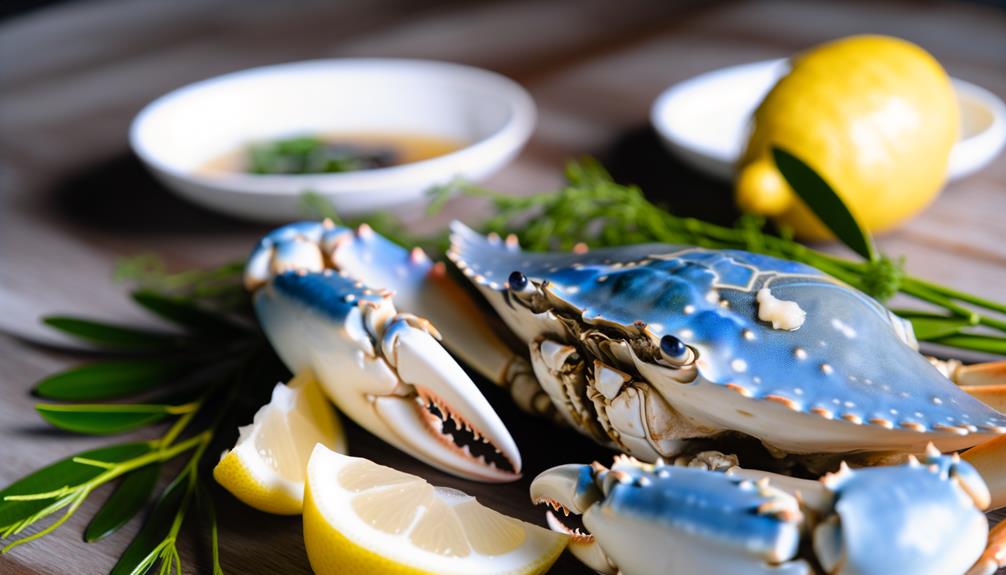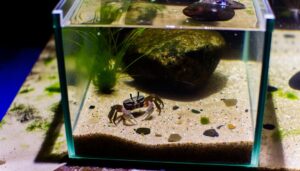Eating Blue Land Crabs: A Guide to Their Edible Taste and Safety
You can definitely eat blue land crabs. They’re rich in protein, low in fat, and packed with essential micronutrients like selenium, zinc, and vitamin B12.
With a firm yet tender texture, their subtly sweet and briny flavor makes them suitable for various dishes. Cooking methods such as boiling, steaming, grilling, or baking are recommended to guarantee they reach a safe internal temperature of 74°C (165°F).
However, be mindful of potential heavy metal contamination and pathogens. For a deeper understanding of their nutritional benefits and culinary applications, consider exploring further.

Key Takeaways
- Blue land crabs are edible and rich in protein, offering around 19 grams per 100-gram serving.
- They have a subtly sweet, briny taste with a firm yet tender texture, suitable for various dishes.
- Cooking methods like boiling, steaming, grilling, and baking ensure flavorful and safe consumption.
- They provide essential nutrients like selenium, zinc, omega-3 fatty acids, and vitamin B12.
- Proper preparation is crucial to avoid potential health risks from heavy metal contamination and pathogens.
6 Aspects: Are Blue Land Crabs Edible
| Aspect | Details |
|---|---|
| Edibility | Yes, blue land crabs are edible and considered a delicacy in many regions like the Caribbean and Central America. |
| Meat Quality | The meat is sweet and tender, especially in the claws, though they yield less meat compared to marine crabs. |
| Legal Regulations | Harvesting is regulated in many places to protect the population. For example, Florida has a specific crab season. |
| Environmental Concerns | They must be sourced from non-polluted areas as land crabs may absorb toxins from their environment. |
| Preparation | They must be thoroughly cooked. Boiling, steaming, or adding them to stews are common preparation methods. |
| Health Safety | Avoid harvesting in areas with known pollutants or toxins as crabs can absorb harmful substances. |
Habitat and Distribution

Blue land crabs mainly inhabit coastal regions, mangroves, and tropical forests where they burrow into sandy or muddy substrates. You’ll find them in regions like the Caribbean, Central America, and the southeastern United States.
These crabs prefer areas with high humidity and temperature, important for their physiological needs and molting processes. Their burrows can be extensive, often reaching depths of up to one meter, designed to avoid predators and maintain moisture levels.
You might notice their seasonal migrations, typically during the rainy season, when they move en masse towards breeding grounds near the shoreline. This behavior not only facilitates reproduction but also guarantees genetic diversity.
Understanding their habitat and distribution is essential for any considerations related to their ecological impact or potential consumption.
Nutritional Content
When considering the nutritional content of blue land crabs, you’ll find they’re rich in protein while being relatively low in fat. A 100-gram serving typically provides around 19 grams of protein and just 2 grams of fat. This protein-to-fat ratio makes blue land crabs an excellent option if you’re looking to maintain muscle mass without excessive fat intake.
They also offer essential micronutrients, including selenium, zinc, and vitamin B12. Selenium contributes to antioxidant defense mechanisms, while zinc supports immune function. Vitamin B12 is crucial for neurological health and blood formation.
Additionally, blue land crabs are low in carbohydrates, making them suitable for low-carb or ketogenic dietary preferences. Overall, their nutritional profile supports a balanced, health-conscious diet.
Taste and Texture

The taste of blue land crabs is often described as subtly sweet and briny, with a firm yet tender texture that holds up well in various culinary applications. This unique flavor profile is due to the specific amino acid composition and the presence of naturally occurring sugars such as glycogen. Their muscle fibers are densely packed, providing a satisfying bite that doesn’t disintegrate easily.
Data indicates a slight variation in taste depending on their diet and habitat, which can influence the levels of minerals like sodium and potassium. You’ll find their texture comparable to that of marine crabs, but with a distinct earthiness. This combination of taste and texture makes blue land crabs a versatile ingredient for diverse dishes.
Cooking Methods
You can employ various cooking methods to optimize the flavor and texture of Blue Land Crabs. Scientific data shows that boiling and steaming techniques preserve moisture and enhance the natural sweetness of the meat.
Meanwhile, grilling and baking tips indicate that these methods impart a smoky flavor and crisp texture, making the crabs a versatile ingredient in culinary applications.
Boiling and Steaming Techniques
Utilizing precise boiling or steaming techniques guarantees that blue land crabs are cooked to perfection, maintaining their delicate texture and rich flavor. When boiling, make sure the water reaches a rolling boil at 100°C (212°F); immerse the crabs for 15-20 minutes, depending on their size. This method achieves best protein denaturation and moisture retention.
For steaming, use a perforated steaming basket, keeping the water just below the basket at approximately 95°C (203°F). Steam the crabs for 20-25 minutes, allowing even heat distribution without direct water contact. Both methods optimize the crabs’ internal temperature reaches 74°C (165°F), critical for food safety.
Grilling and Baking Tips
For those seeking alternative methods to achieve perfectly cooked blue land crabs, grilling and baking offer robust flavors and textures while maintaining the necessary internal temperature of 74°C (165°F) for food safety.
Grilling imparts a smoky flavor, while baking allows for even heat distribution. Follow these steps for best outcomes:
- Grilling: Preheat grill to 230°C (450°F). Brush crabs with oil, place on the grill, and cook for 10-15 minutes, flipping midway.
- Baking: Preheat oven to 190°C (375°F). Place seasoned crabs on a baking sheet and bake for 20-25 minutes.
- Internal Temperature: Always use a meat thermometer to confirm crabs reach 74°C (165°F).
These methods provide flavorful, safe-to-eat blue land crabs.
Health Benefits

When considering the health benefits of blue land crabs, you’ll find that they’re rich in protein, omega-3 fatty acids, and essential minerals like zinc and selenium.
However, it’s important to be aware of potential health risks, such as contamination by heavy metals and parasites.
Let’s examine the nutritional value analysis and assess these risks to provide a detailed overview.
Nutritional Value Analysis
How does the nutrient profile of blue land crabs contribute to their potential health benefits?
Blue land crabs are rich in essential nutrients that enhance your well-being. Their high protein content supports muscle growth and repair.
Furthermore, they contain omega-3 fatty acids, which contribute to cardiovascular health and cognitive function.
Here’s a concise breakdown of their nutritional advantages:
- Protein: Provides approximately 19 grams per 100 grams, vital for muscle synthesis.
- Omega-3 Fatty Acids: About 0.3 grams per serving, promoting heart health and reducing inflammation.
- Vitamins and Minerals: High in B vitamins, zinc, and selenium, necessary for metabolic processes and immune function.
Potential Health Risks
Consuming blue land crabs may expose you to potential health risks due to contaminants like heavy metals and pathogens. Studies have detected elevated levels of mercury, lead, and cadmium in their tissues, posing neurotoxic and nephrotoxic risks if ingested frequently. Additionally, blue land crabs can harbor Vibrio species and other bacteria, leading to gastrointestinal issues.
Thorough cooking can mitigate bacterial threats, but heavy metal contamination remains a concern as it accumulates over time. If you decide to consume blue land crabs, opt for those sourced from less contaminated regions and limit intake to minimize health risks. Ensuring proper handling and preparation will further reduce potential adverse effects, giving you more freedom to enjoy this delicacy safely.
Safety Concerns
Examining the safety concerns surrounding the consumption of blue land crabs reveals critical factors such as potential toxicity, proper preparation methods, and environmental contaminants.
To make sure you’re making informed choices, consider the following:
- Potential Toxicity: Blue land crabs can accumulate toxins, especially if they feed on harmful substances. Always acquire crabs from reputable suppliers.
- Proper Preparation: Cooking thoroughly is crucial to eliminate any harmful bacteria or parasites. Undercooked crab meat can pose serious health risks.
- Environmental Contaminants: Blue land crabs may inhabit polluted areas, absorbing heavy metals like mercury. Regular testing of their habitat can offer data on contamination levels.
Conclusion
You’ll find it fascinating that blue land crabs, found primarily in mangroves and coastal regions, aren’t just edible but also nutritionally dense, offering protein, vitamins, and minerals.
Coincidentally, their taste and texture are comparable to their marine counterparts, making them versatile for various cooking methods.
While they provide numerous health benefits, always guarantee proper handling and cooking to avoid potential safety concerns.
So, if you’re adventurous in your culinary pursuits, blue land crabs are a nutritious and delicious option.






